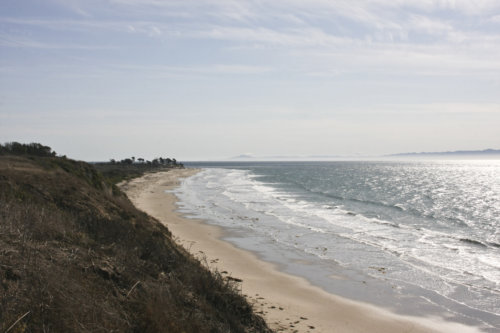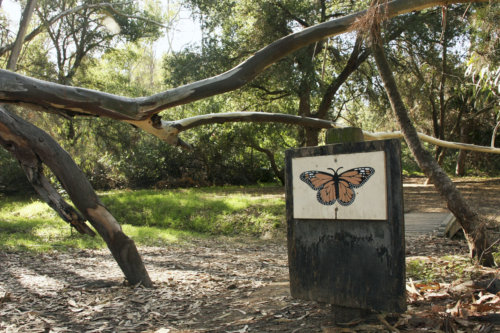
The Goleta Butterfly Preserve Is An Enchanting Find
Amid the mad rush to plant Blue Gum eucalyptus groves in Southern California at the turn of the 20th century, the perfect haven for monarch butterflies was unwittingly created by a local rancher. While the promises of eucalyptus as building timber didn’t work out, groves of the trees have thrived throughout the region. The Goleta Butterfly Preserve (also called the Ellwood Butterfly Preserve) in Goleta, California is one such surviving eucalyptus grove that has become the largest of about 300 sites along the California and Mexican coastline for overwintering monarch butterflies.
The scene at the reserve is spectacular—meandering trails lead visitors through shaded soft greens of shedding eucalyptus, acacia trees, and coastal sage. Moist ocean air mixes with the clean scent of eucalyptus oil. Slowly you begin to see them—just one or two at first, and perhaps a small flutter here, another there. Looking up, trees are covered and alive with orange- and black-winged creatures. Look closely—the muted oranges and browns of closed wings can look like clumps of dry leaves. With the right timing, tens of thousands of butterflies may be on view, resting wing to wing, making branches heavy and covering trunks.
“While Cooper’s eucalyptus passion project was a failure, he managed to create a cream-of-the-crop resort for butterflies and a place of awe for humans.”
We have Ellwood Cooper to thank for this incredible showing. This early Southern California horticulturalist was one of the main eucalyptus boosters of the region, calling on residents to plant the Australian trees that would turn the landscape into “the paradise of the world.” He settled in Goleta in 1870, where he planted tens of thousands of walnuts, citrus, olives, grapes, persimmon, and almond trees. While Cooper’s eucalyptus passion project was a failure, he managed to create a cream-of-the-crop resort for butterflies and a place of awe for humans.
Monarch butterflies make a yearly migration to this wintering spot with the help of a built-in magnetic compass– the same bio-adapted feature that helps birds make their own annual migrations. Escaping cold winter temperatures, monarchs seek wind-protected areas with access to water to roost on trees—namely eucalyptus, Monterrey Pine, and Monterrey Cypress. Prior to the 1920s, monarchs were not regular visitors to this area of coastal California. Their native winter territory lies further south, in and around Baja, Mexico. It is believed that some odd weather patterns first brought a few wayward monarchs to the grove in Goleta, which they found favorable.
The butterflies began to make return trips to the area in the 1920s. The local monarch population peaked in the 1960s, when upwards of 200,000 monarch spent their winters here. Numbers of this magnitude haven’t been seen in decades thanks to the dwindling of protected woodland and native milkweed (the food of choice for monarchs).
The Goleta Butterfly Preserve is located adjacent to the Coronado Butterfly Preserve, atop a bluff off California’s 101 Freeway, just north of Santa Barbara. There is no admission fee to the grove and parking is free. You can find the trailhead and parking at Ellwood Mesa Open Space parking lot on Hollister Avenue. (There is a half-mile walk to the grove, and close-toed shoes are recommended.) You’ll likely want a camera and binoculars as well.
Monarchs are typically present from mid-November to mid-February, with peak populations coming to Goleta in December and January. The best time to view the butterflies is in the morning, when they are likely to be roosting and less active. Interested parties can consult the preserve website for updated butterfly counts to ensure you see the best of this unforgettable spectacle.




































